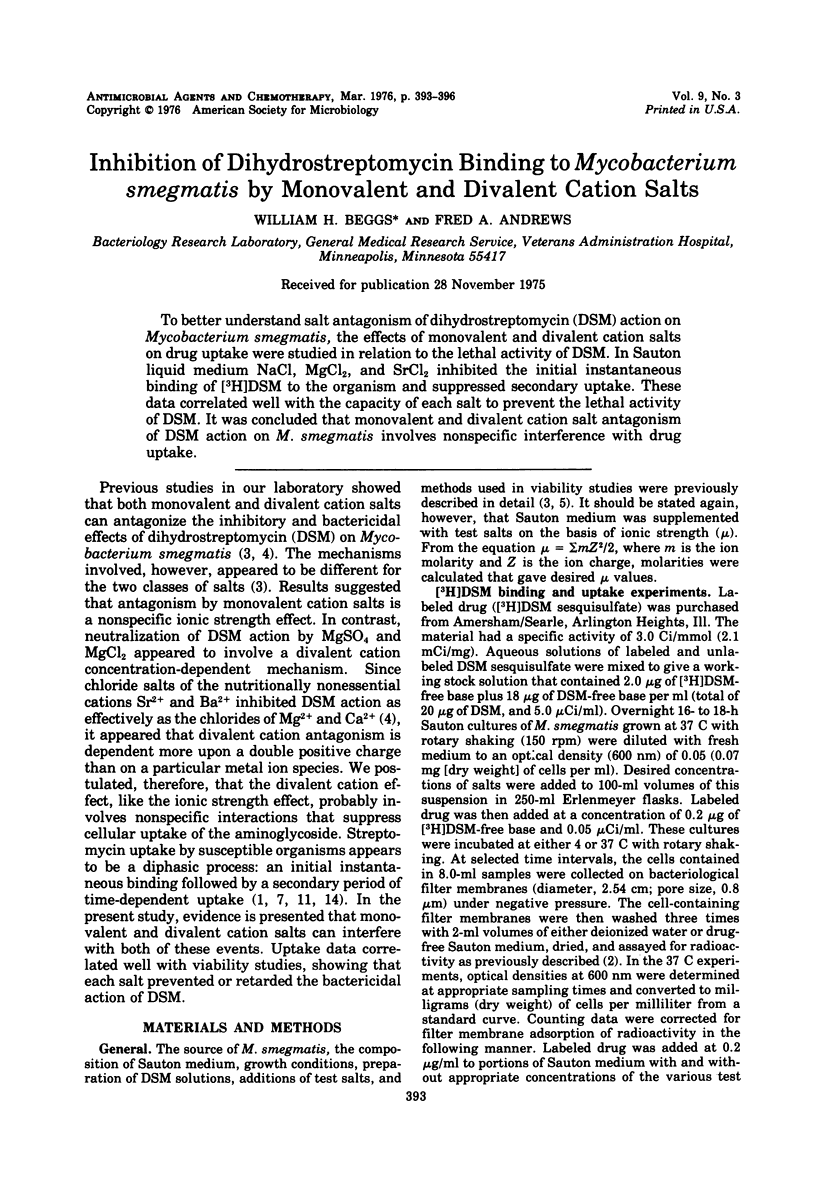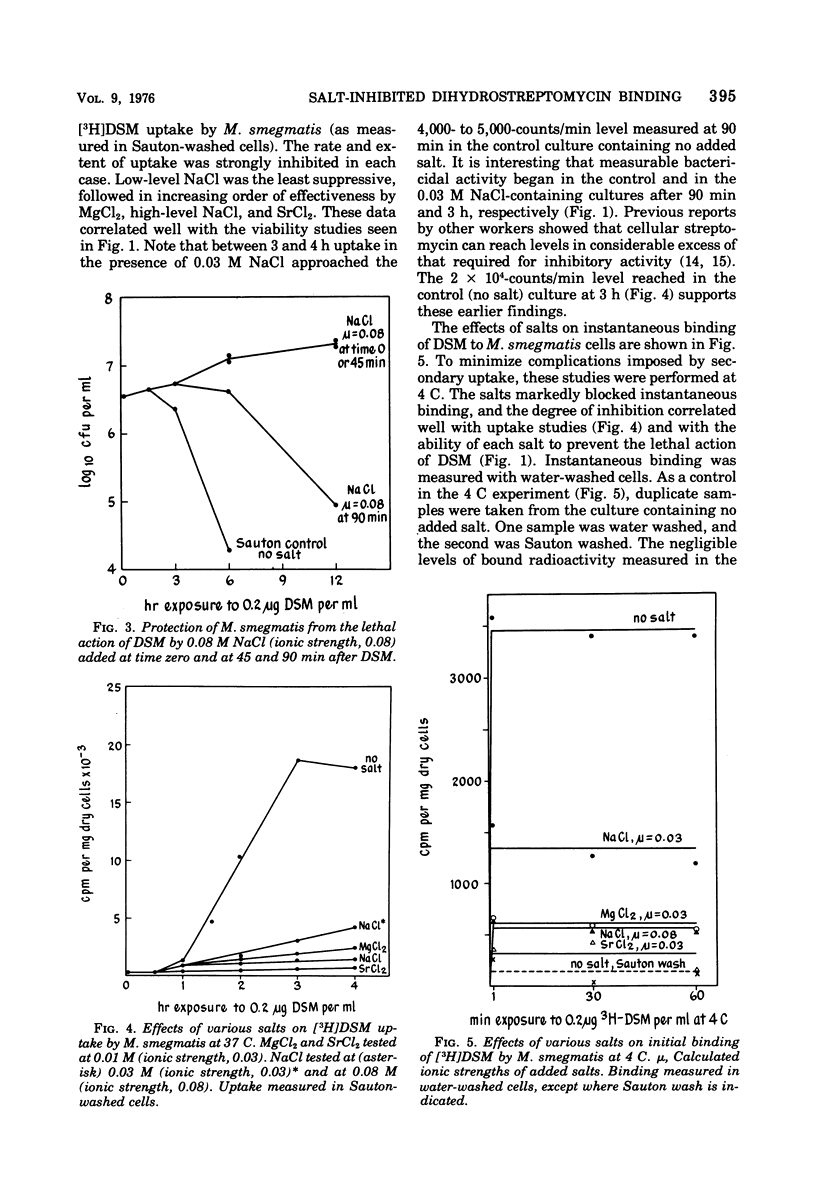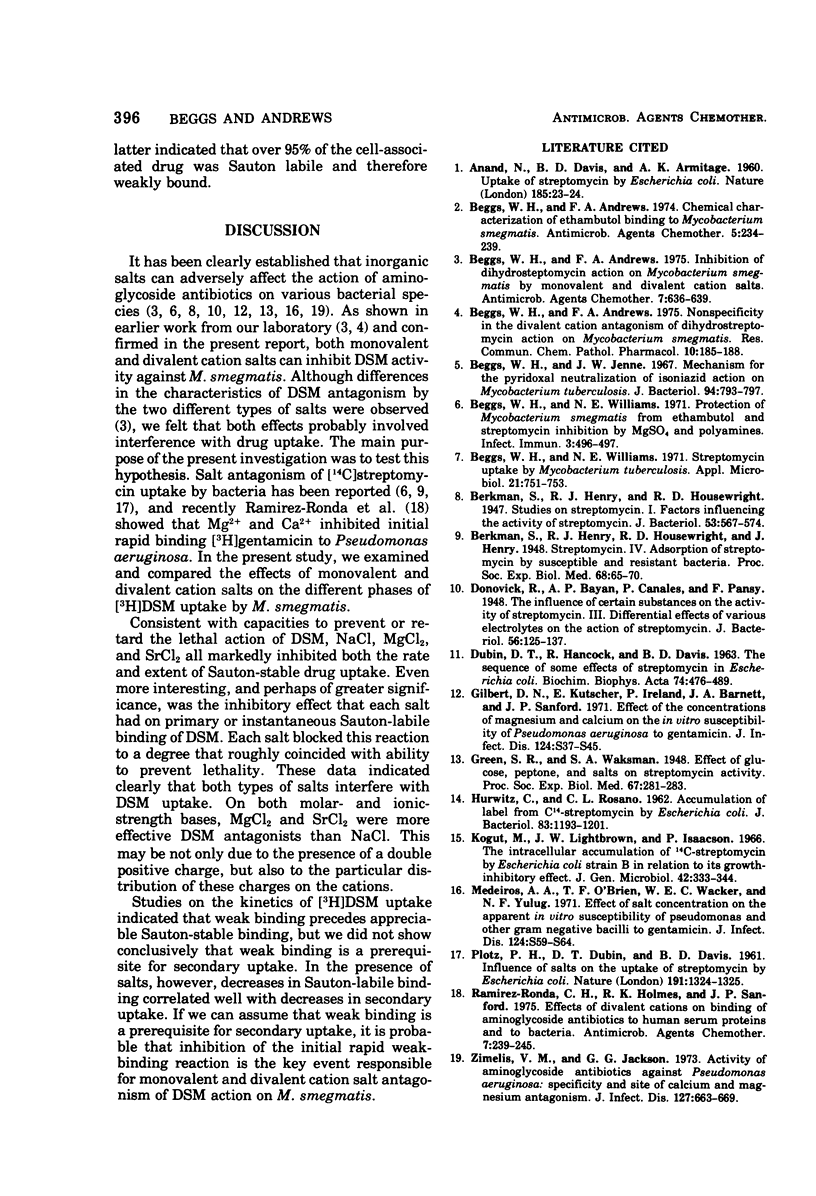Abstract
To better understand salt antagonism of dihydrostreptomycin (DSM) action on Mycobacterium smegmatis, the effects of monovalent and divalent cation salts on drug uptake were studied in relation to the lethal activity of DSM. In Sauton liquid medium NaCl, MgCl2, and SrCl2 inhibited the initial instantaneous binding of [3H]DSM to the organism and suppressed secondary uptake. These data correlated well with the capacity of each salt to prevent the lethal activity of DSM. It was concluded that monovalent and divalent cation salt antagonism of DSM action on M. smegmatis involves nonspecific interference with drug uptake.
Full text
PDF



Selected References
These references are in PubMed. This may not be the complete list of references from this article.
- ANAND N., DAVIS B. D., ARMITAGE A. K. Uptake of streptomycin by Escherichia coli. Nature. 1960 Jan 2;185:23–24. doi: 10.1038/185023a0. [DOI] [PubMed] [Google Scholar]
- Beggs W. H., Andrews F. A. Chemical characterization of ethambutol binding to Mycobacterium smegmatis. Antimicrob Agents Chemother. 1974 Mar;5(3):234–239. doi: 10.1128/aac.5.3.234. [DOI] [PMC free article] [PubMed] [Google Scholar]
- Beggs W. H., Andrews F. A. Inhibition of dihydrostreptomycin action on Mycobacterium smegmatis by monovalent and divalent cation salts. Antimicrob Agents Chemother. 1975 May;7(5):636–639. doi: 10.1128/aac.7.5.636. [DOI] [PMC free article] [PubMed] [Google Scholar]
- Beggs W. H., Andrews F. A. Nonspecificity in the divalent cation antagonism of dihydrostreptomycin action on Mycobacterium smegmatis. Res Commun Chem Pathol Pharmacol. 1975 Jan;10(1):185–188. [PubMed] [Google Scholar]
- Beggs W. H., Jenne J. W. Mechanism for the pyridoxal neutralization of isoniazid action of Mycobacterium tuberculosis. J Bacteriol. 1967 Oct;94(4):793–797. doi: 10.1128/jb.94.4.793-797.1967. [DOI] [PMC free article] [PubMed] [Google Scholar]
- Beggs W. H., Williams N. E. Protection of Mycobacterium smegmatis from Ethambutol and Streptomycin Inhibition by MgSO(4) and Polyamines. Infect Immun. 1971 Mar;3(3):496–497. doi: 10.1128/iai.3.3.496-497.1971. [DOI] [PMC free article] [PubMed] [Google Scholar]
- Beggs W. H., Williams N. E. Streptomycin uptake by Mycobacterium tuberculosis. Appl Microbiol. 1971 Apr;21(4):751–753. doi: 10.1128/am.21.4.751-753.1971. [DOI] [PMC free article] [PubMed] [Google Scholar]
- Berkman S., Henry R. J., Housewright R. D. Studies on Streptomycin: I. Factors Influencing the Activity of Streptomycin. J Bacteriol. 1947 May;53(5):567–574. [PMC free article] [PubMed] [Google Scholar]
- DUBIN D. T., HANCOCK R., DAVIS B. D. THE SEQUENCE OF SOME EFFECTS OF STREPTOMYCIN IN ESCHERICHIA COLI. Biochim Biophys Acta. 1963 Aug 13;74:476–489. doi: 10.1016/0006-3002(63)91390-8. [DOI] [PubMed] [Google Scholar]
- Donovick R., Bayan A. P., Canales P., Pansy F. The Influence of Certain Substances on the Activity of Streptomycin: III. Differential Effects of Various Electrolytes on the Action of Streptomycin. J Bacteriol. 1948 Jul;56(1):125–137. [PMC free article] [PubMed] [Google Scholar]
- Gilbert D. N., Kutscher E., Ireland P., Barnett J. A., Sanford J. P. Effect of the concentrations of magnesium and calcium on the in-vitro susceptibility of Pseudomonas aeruginosa to gentamicin. J Infect Dis. 1971 Dec;124 (Suppl):S37–S45. doi: 10.1093/infdis/124.supplement_1.s37. [DOI] [PubMed] [Google Scholar]
- HURWITZ C., ROSANO C. L. Accumulation of label from C14-streptomycin by Escherichia coli. J Bacteriol. 1962 Jun;83:1193–1201. doi: 10.1128/jb.83.6.1193-1201.1962. [DOI] [PMC free article] [PubMed] [Google Scholar]
- Kogut M., Lightbown J. W., Isaacson P. The intracellular accumulation of 14-C-streptomycin by Escherichia coli strain B in relation to its growth-inhibitory effect. J Gen Microbiol. 1966 Mar;42(3):333–344. doi: 10.1099/00221287-42-3-333. [DOI] [PubMed] [Google Scholar]
- Medeiros A. A., O'Brien T. F., Wacker W. E., Yulug N. F. Effect of salt concentration on the apparent in-vitro susceptibility of Pseudomonas and other gram-negative bacilli to gentamicin. J Infect Dis. 1971 Dec;124 (Suppl):S59–S64. doi: 10.1093/infdis/124.supplement_1.s59. [DOI] [PubMed] [Google Scholar]
- PLOTZ P. H., DUBIN D. T., DAVIS B. D. Influence of salts on the uptake of streptomycin by Escherichia coli. Nature. 1961 Sep 23;191:1324–1325. doi: 10.1038/1911324a0. [DOI] [PubMed] [Google Scholar]
- Ramirez-Ronda C. H., Holmes R. K., Sanford J. P. Effects of divalent cations on binding of aminoglycoside antibiotics to human serum proteins and to bacteria. Antimicrob Agents Chemother. 1975 Mar;7(3):239–245. doi: 10.1128/aac.7.3.239. [DOI] [PMC free article] [PubMed] [Google Scholar]
- Zimelis V. M., Jackson G. G. Activity of aminoglycoside antibiotics aganst Pseudomonas aeruginosa: specificity and site of calcium and magnesium antagonism. J Infect Dis. 1973 Jun;127(6):663–669. doi: 10.1093/infdis/127.6.663. [DOI] [PubMed] [Google Scholar]


